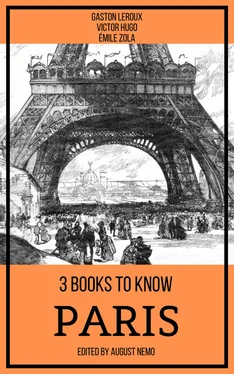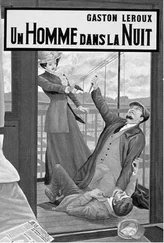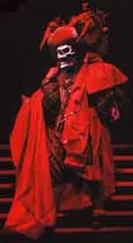CHAPTER II. THE PLACE DE GREVE.
––––––––
THERE REMAINS TO-DAY but a very imperceptible vestige of the Place de Grève, such as it existed then; it consists in the charming little turret, which occupies the angle north of the Place, and which, already enshrouded in the ignoble plaster which fills with paste the delicate lines of its sculpture, would soon have disappeared, perhaps submerged by that flood of new houses which so rapidly devours all the ancient façades of Paris.
The persons who, like ourselves, never cross the Place de Grève without casting a glance of pity and sympathy on that poor turret strangled between two hovels of the time of Louis XV., can easily reconstruct in their minds the aggregate of edifices to which it belonged, and find again entire in it the ancient Gothic place of the fifteenth century.
It was then, as it is to-day, an irregular trapezoid, bordered on one side by the quay, and on the other three by a series of lofty, narrow, and gloomy houses. By day, one could admire the variety of its edifices, all sculptured in stone or wood, and already presenting complete specimens of the different domestic architectures of the Middle Ages, running back from the fifteenth to the eleventh century, from the casement which had begun to dethrone the arch, to the Roman semicircle, which had been supplanted by the ogive, and which still occupies, below it, the first story of that ancient house de la Tour Roland, at the corner of the Place upon the Seine, on the side of the street with the Tannerie. At night, one could distinguish nothing of all that mass of buildings, except the black indentation of the roofs, unrolling their chain of acute angles round the place; for one of the radical differences between the cities of that time, and the cities of the present day, lay in the façades which looked upon the places and streets, and which were then gables. For the last two centuries the houses have been turned round.
In the centre of the eastern side of the Place, rose a heavy and hybrid construction, formed of three buildings placed in juxtaposition. It was called by three names which explain its history, its destination, and its architecture: “The House of the Dauphin,” because Charles V., when Dauphin, had inhabited it; “The Marchandise,” because it had served as town hall; and “The Pillared House” (domus ad piloria), because of a series of large pillars which sustained the three stories. The city found there all that is required for a city like Paris; a chapel in which to pray to God; a plaidoyer, or pleading room, in which to hold hearings, and to repel, at need, the King’s people; and under the roof, an arsenac full of artillery. For the bourgeois of Paris were aware that it is not sufficient to pray in every conjuncture, and to plead for the franchises of the city, and they had always in reserve, in the garret of the town hall, a few good rusty arquebuses. The Grève had then that sinister aspect which it preserves to-day from the execrable ideas which it awakens, and from the sombre town hall of Dominique Bocador, which has replaced the Pillared House. It must be admitted that a permanent gibbet and a pillory, “a justice and a ladder,” as they were called in that day, erected side by side in the centre of the pavement, contributed not a little to cause eyes to be turned away from that fatal place, where so many beings full of life and health have agonized; where, fifty years later, that fever of Saint Vallier was destined to have its birth, that terror of the scaffold, the most monstrous of all maladies because it comes not from God, but from man.
It is a consoling idea (let us remark in passing), to think that the death penalty, which three hundred years ago still encumbered with its iron wheels, its stone gibbets, and all its paraphernalia of torture, permanent and riveted to the pavement, the Grève, the Halles, the Place Dauphine, the Cross du Trahoir, the Marché aux Pourceaux, that hideous Montfauçon, the barrier des Sergents, the Place aux Chats, the Porte Saint-Denis, Champeaux, the Porte Baudets, the Porte Saint Jacques, without reckoning the innumerable ladders of the provosts, the bishop of the chapters, of the abbots, of the priors, who had the decree of life and death,—without reckoning the judicial drownings in the river Seine; it is consoling to-day, after having lost successively all the pieces of its armor, its luxury of torment, its penalty of imagination and fancy, its torture for which it reconstructed every five years a leather bed at the Grand Châtelet, that ancient suzerain of feudal society almost expunged from our laws and our cities, hunted from code to code, chased from place to place, has no longer, in our immense Paris, any more than a dishonored corner of the Grève,—than a miserable guillotine, furtive, uneasy, shameful, which seems always afraid of being caught in the act, so quickly does it disappear after having dealt its blow.
CHAPTER III. KISSES FOR BLOWS.
––––––––
WHEN PIERRE GRINGOIRE arrived on the Place de Grève, he was paralyzed. He had directed his course across the Pont aux Meuniers, in order to avoid the rabble on the Pont au Change, and the pennons of Jehan Fourbault; but the wheels of all the bishop’s mills had splashed him as he passed, and his doublet was drenched; it seemed to him besides, that the failure of his piece had rendered him still more sensible to cold than usual. Hence he made haste to draw near the bonfire, which was burning magnificently in the middle of the Place. But a considerable crowd formed a circle around it.
“Accursed Parisians!” he said to himself (for Gringoire, like a true dramatic poet, was subject to monologues) “there they are obstructing my fire! Nevertheless, I am greatly in need of a chimney corner; my shoes drink in the water, and all those cursed mills wept upon me! That devil of a Bishop of Paris, with his mills! I’d just like to know what use a bishop can make of a mill! Does he expect to become a miller instead of a bishop? If only my malediction is needed for that, I bestow it upon him! and his cathedral, and his mills! Just see if those boobies will put themselves out! Move aside! I’d like to know what they are doing there! They are warming themselves, much pleasure may it give them! They are watching a hundred fagots burn; a fine spectacle!”
On looking more closely, he perceived that the circle was much larger than was required simply for the purpose of getting warm at the king’s fire, and that this concourse of people had not been attracted solely by the beauty of the hundred fagots which were burning.
In a vast space left free between the crowd and the fire, a young girl was dancing.
Whether this young girl was a human being, a fairy, or an angel, is what Gringoire, sceptical philosopher and ironical poet that he was, could not decide at the first moment, so fascinated was he by this dazzling vision.
She was not tall, though she seemed so, so boldly did her slender form dart about. She was swarthy of complexion, but one divined that, by day, her skin must possess that beautiful golden tone of the Andalusians and the Roman women. Her little foot, too, was Andalusian, for it was both pinched and at ease in its graceful shoe. She danced, she turned, she whirled rapidly about on an old Persian rug, spread negligently under her feet; and each time that her radiant face passed before you, as she whirled, her great black eyes darted a flash of lightning at you.
All around her, all glances were riveted, all mouths open; and, in fact, when she danced thus, to the humming of the Basque tambourine, which her two pure, rounded arms raised above her head, slender, frail and vivacious as a wasp, with her corsage of gold without a fold, her variegated gown puffing out, her bare shoulders, her delicate limbs, which her petticoat revealed at times, her black hair, her eyes of flame, she was a supernatural creature.
Читать дальше









